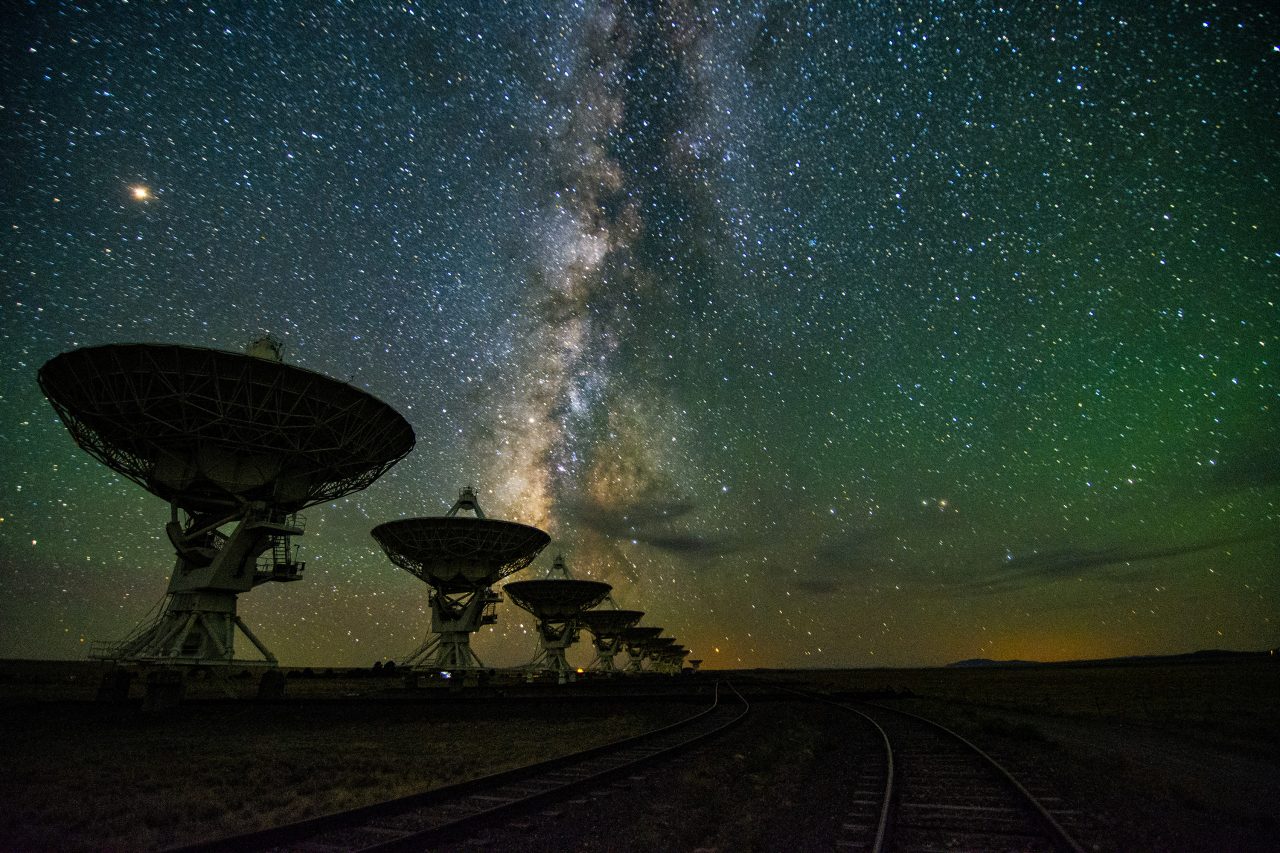AUI will present at the 247th meeting of the American Astronomical Society in Phoenix from January 4-8.
Recent News
ALMA Helps Unmask Monster Black Hole Behind Record-Breaking Cosmic Burst
Astronomers have used the Atacama Large Millimeter/submillimeter Array (ALMA) together with a suite of space- and ground-based telescopes, to study AT 2024wpp, the most luminous fast blue optical transient (LFBOT) ever observed.
Astronomers Make First Radio Detection of Rare Supernova Type, Revealing Secrets of Stellar Death
Astronomers using the U.S. National Science Foundation Very Large Array have captured the first-ever radio signals from a rare class of stellar explosion known as a Type Ibn supernova.
NSF and SpaceX Finalize Radio Spectrum Coordination Agreement
Credit: NRAO/AUI/NSF, Jeff Hellerman
The National Science Foundation (NSF) and SpaceX have finalized a radio spectrum coordination agreement to limit interference from the company’s Starlink satellites to radio astronomy assets operating between 10.6 and 10.7 GHz. The agreement, detailed in a statement released by NSF today, ensures that Starlink satellite network plans will meet international radio astronomy protection standards, and protect NSF-funded radio astronomy facilities, including the National Radio Astronomy Observatory (NRAO) and the Green Bank Observatory (GBO). The agreement will also positively impact collaborations and cooperation between SpaceX and NSF’s NOIRLab.
“We are setting the stage for a successful partnership between commercial and public endeavors that allows important science research to flourish alongside satellite communication,” said NSF Director Sethuraman Panchanathan, in the NSF statement.
Tony Beasley, NRAO Director and Vice President for Radio Astronomy at Associated Universities Inc. (AUI) added, “Cooperation between commercial satellite providers and research facilities is essential to ensuring the future of these two major industries that both rely on the limited radio spectrum. This landmark agreement between NSF and SpaceX proves that collaboration between commercial entities and research facilities is not only a possibility, but also a positive path forward for additional cooperative opportunities.”
In May 2019, SpaceX launched its first 60 Starlink satellites into orbit, prompting attention from the astronomy community. As of December 2022, Starlink has over 3,000 satellites in orbit. The ever-growing presence of small satellites in the radio spectrum has created a potential for cross-over between bands, and a need for better communication between active and passive users to reduce interference.
“This agreement echoes protections in place in the National Radio Quiet Zone (NRQZ) that protect the radio spectrum from terrestrial based radio interference. These combined efforts, of land and sky, will safeguard the scientific research of astronomers for generations to come,” said Jim Jackson, GBO Director. GBO is located in the heart of the NRQZ, which was established in 1958 to protect federal radio observations conducted in a 14,000 square mile region spanning West Virginia, and parts of Virginia and Maryland.
NRAO has been collaborating with SpaceX since 2021 to test the impact of Starlink satellites on radio astronomy observations conducted between 10.6 and 10.7 GHz. Additional tests have monitored the level of impact in the 10.7-12.27 GHz and 14.0-14.5 GHz ranges. The results have provided scientists with a better understanding of the actual and potential impacts of satellites on research, and paved the way for this agreement.
In the past two years, NSF has funded the efforts of the National Radio Dynamic Zone (NRDZ) and Spectrum Innovation Initiative, which are collaborations created by multiple organizations, including NRAO, to define and eventually monitor the NRDZ. “NRAO is dedicated to the protection of radio astronomical observations in the decades ahead, which will be challenging. Experiments in coordinated spectrum use like the ones that we are performing with SpaceX will provide a strong foundation for the type of testing and analysis that could occur in an NRDZ,” said Chris De Pree NRDZ Project Director at NRAO.
Above and beyond the current agreement, NSF and SpaceX will continue to explore ways to further protect radio astronomy while still allowing commercial satellite operations to flourish.
“It is important that we are all at the table from the very beginning of the design phase, and pursue solutions that work for the needs of scientists, business, and the public,” said Adam Cohen, President and CEO of AUI. “Having the support and guidance of NSF through this process and the support and cooperation of SpaceX will safeguard the future of radio astronomy and astronomy in general.”
The National Radio Astronomy Observatory and the Green Bank Observatory are facilities of the National Science Foundation operated under cooperative agreement by AUI.
Media Contacts:
Amy C. Oliver
Public Information and News Manager, NRAO
Public Information Officer, ALMA-North America
Tel: +1 434-296-0314
[email protected]
Dave Finley
Public Information Officer, NRAO-VLA, VLBA
Tel: +1 505-241-9210
[email protected]
Jill Malusky
Public Information Officer, Green Bank Observatory
Tel: +1 304-456-5608
[email protected]
This news article was originally published on the NRAO website on January 10, 2023.
Recent News
AUI to Attend AAS 247 Conference
AUI will present at the 247th meeting of the American Astronomical Society in Phoenix from January 4-8.
ALMA Helps Unmask Monster Black Hole Behind Record-Breaking Cosmic Burst
Astronomers have used the Atacama Large Millimeter/submillimeter Array (ALMA) together with a suite of space- and ground-based telescopes, to study AT 2024wpp, the most luminous fast blue optical transient (LFBOT) ever observed.
Astronomers Make First Radio Detection of Rare Supernova Type, Revealing Secrets of Stellar Death
Astronomers using the U.S. National Science Foundation Very Large Array have captured the first-ever radio signals from a rare class of stellar explosion known as a Type Ibn supernova.

